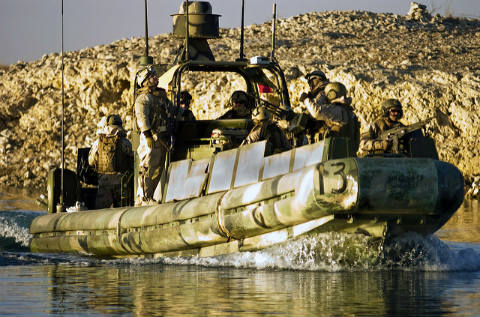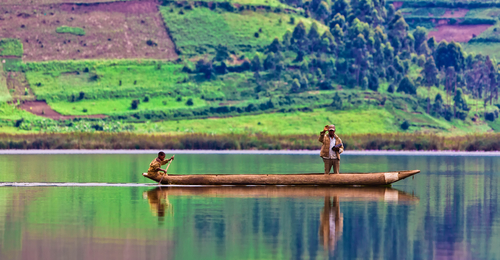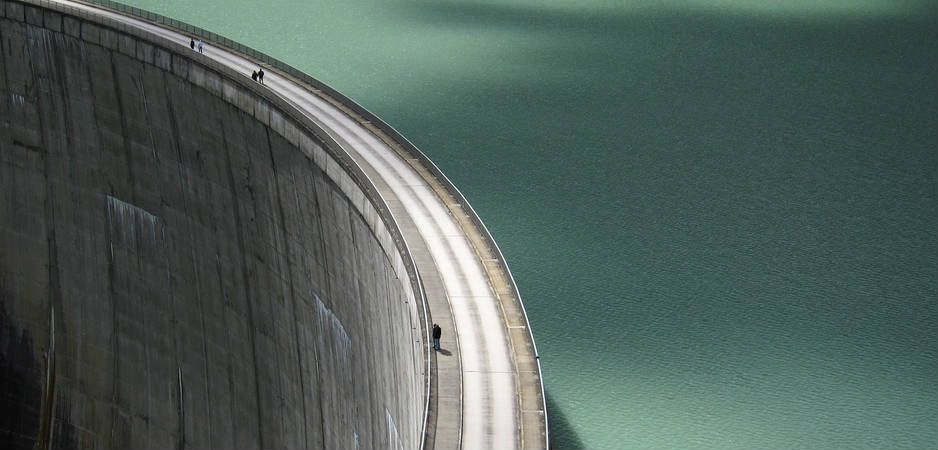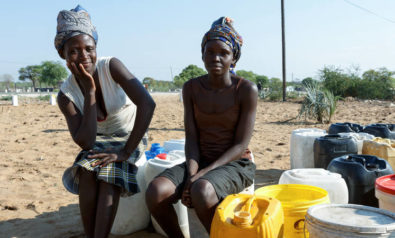In times of war, lack of access to safe water can kill as many people as bombing.
Inequality in the distribution of water resources and risks of shortage are contributing causes of tension and conflict between states. The conflict in Darfur, characterized by rivalry between local communities and tribes for access to arable land and water resources, is a prime example of such a relationship between conflict and scarcity of natural resources.
Yet there is another dynamic: Armed conflicts also damage water resources both in the short and long terms, compromising both the health and, in some circumstances, the survival of local populations.
Attractive Targets
Unlike peacetime legislation, the law of armed conflict (or international humanitarian law) contains few rules that relate directly to the protection of freshwater resources. Nevertheless, access to and the protection of water installations may be significantly affected by wars. Dams and dykes have often represented an attractive target for the parties in a conflict. A 2016 report of the German Institute for International and Security Affairs points out that the control of strategic dams on the Tigris and Euphrates rivers have been at the center of military operations carried out by the Islamic State (IS) in Syria and Iraq. Control of the Mosul dam in 2014 set off alarm bells around the world.
The control of water installations allows IS to dispose of large amounts of water and energy to sustain the extraction, processing and selling of crude oil that continue to provide the financial basis to the militia. The US led anti-IS coalition supported both the Kurdish and Iraqi armies to ensure the control of the dams in the Euphrates and Tigris rivers and impeding the control of these strategic installations that strengthens the powers of the caliphate in the Middle East. However, major dams such as those at Fallujah and Ramadi are still in the hands of IS.
The risks entailed by the control of dams are multiple. The first type of risk is that too little water is available to the civilian population. Whoever has the control of the dams can cause downstream droughts and cut energy and water supplies to entire towns.
The second type of risk is the release of too much water, flooding kilometers of farmland areas, killing livestock and causing casualties and displacement.
A third type of risk is the insufficient quality of water. It has been reported that IS poisoned drinking water supplies in Aleppo and Baghdad. Moreover, this threat risks to be exported in Europe. In 2015, there has been a risk of an attack on the water supplies in Pristina that was prevented just before its planned execution.
Indirect Effects
The effect of armed conflict on water resources can also be indirect. During the 1999 NATO air strikes in Kosovo, the destruction of refineries and other industrial facilities located in the banks of the Danube caused the release of polluting substances in the river and groundwater resources. The report of the Balkan Task Force, jointly established by the United Nations Environment Program (UNEP) and the UN Centre for Human Settlements (UNCHS/Habitat), affirms that their “findings indicate that the Kosovo conflict has not caused an environmental catastrophe affecting the Balkans region as a whole,” it recognizes nevertheless that “pollution detected at some sites is serious and poses a threat to human health.”

Haditha Dam, 2007 © Flickr
In another assessment report of environmental damage in Bosnia-Herzegovina, UNEP observed that, during the conflict in Kosovo, the use of depleted uranium caused the contamination of some groundwater resources. Although the contamination of the sites has not exceeded the levels recommended by the World Health Organization (WHO), the UNEP study points out that the sites where the contamination have been detected and should be monitored.
The protection of water during armed conflicts should be strengthened. In 1994, an expert meeting organized by the International Committee of the Red Cross (ICRC) in Montreux affirmed that, in times of war, the lack of access to safe water and the problems of public health may kill as many people as bombing. After more than 20 years, in 2015, an ICRC study underlines that 50 million people are affected by armed conflicts in urban areas and suffer from limitations in water supplies. Armed conflict can impact water services either directly, such as a reservoir pierced by a tank shell, or indirectly, when insecurity can prevent engineers from gaining safe access to keep water and electrical networks operational in the long run.
The Law of Armed Conflict
International humanitarian law expressly mentions that military attacks against drinking water installations and supplies as well as irrigation works are prohibited (Article 54 of the 1977 First Protocol to the 1949 Geneva Conventions and Article 14 of the 1977 Second Protocol to the 1949 Geneva Conventions). Drinking water installations are not the only civilian objects that may be indispensable to the survival of the civilian population. Other examples include power plants providing water supplies. During armed conflicts, attacks against them are very common. One example is the bombing of the power plant in Gaza in 2006.
The 1977 protocols provide an illustrative list of protected objects. This list could be expanded to include other objects such as power plants supplying energy for water supplies. In fact, it makes no difference whether a drinking water facility is attacked and destroyed, or is made inoperable by the destruction of the electrical plant supplying its power. In either case, civilians suffer the same effects: They are denied of the use of a public utility indispensable for their survival.
Another specific rule dealing with the protection of water during armed conflicts concerns the prohibition of attacking dams. Both 1977 Protocols provide for this rule—Article 56 of the 1977 First Protocol to the 1949 Geneva Conventions and Article 15 of the 1977 Second Protocol to the 1949 Geneva Conventions. Dams may often provide water supplies to urbanized areas. A case in point is the Inga dam located near Kinshasa in the Democratic Republic of Congo (DRC). During the occupation of some regions of DRC during the 1990s, Ugandan military forces took possession of this hydroelectric facility and threatened to cut water supplies to the civilian population of Kinshasa.
Other rules which can ensure protection of water during the conduct of hostilities deal with the protection of the environment. The First Protocol provides two articles regarding this issue. Articles 35.3 and 55 protect the environment against “widespread, long-term and severe damage.” The adjectives “widespread, long-term, and severe” used in the First Protocol mean that it is a triple, cumulative standard that needs to be fulfilled.
This is a very high threshold of application. The conditions of application of Articles 35.3 and 55 are extremely stringent. For example, the notion of “long-term” employed by the protocol was defined as lasting for a period of decades. The application of these articles could be only invoked in situations of extreme pollution of freshwater resources.
Comprehensive Protection
The protection of water resources and water-related installations in armed conflicts has been viewed primarily through the lens of international humanitarian law. However, this perspective is too narrow. A more comprehensive protection of the access to water may be provided by the recourse to human rights instruments.
The UN Economic, Social and Cultural Rights (ESCR) Committee is charged of the interpretation of the rights embodied in the 1966 Covenant. In 2002, the ESCR Committee adopted General Comment No.15 on the right to water, which recognizes that this right relies on Articles 11 and 12 of the Covenant. General Comment No.15 analyzes several facets of the right to water, in particular aspects linked to quality, quantity and accessibility of water. It also explicitly recognizes the link between human rights law and international humanitarian law. In particular, it affirms that the right to water consists of “not limiting access to, or destroying, water services and infrastructure as a punitive measure for example, during armed conflicts in violation of international humanitarian law.”

LAKE BUNYONYI, UGANDA © Shutterstock
A further reading of the relation between water and armed conflict concerns the protection of this natural resource as such. In this context, the development of various instruments regarding transboundary water resources plays an important role. These instruments continue to be applied in times of armed conflict. For example, the 1997 Convention on the Law of Non-Navigational Uses of International Watercourses and the 2008 Draft Articles on the Law of Transboundary Aquifers contain similar provisions dealing with armed conflicts. Article 29 of the 1997 UN Watercourses Convention affirms that transboundary freshwater resources “shall enjoy the protection accorded by the principles and rules of international law applicable in international and non-international armed conflict and shall not be used in violation of those principles and rules.”
International water law norms could provide a tool of cooperation between parties involved in a dispute. In regions that have been pointed out as at risk of “water wars,” instruments dealing with transboundary water resources have served as a basis of dialogue between riparian states. This was the case, for instance, for the agreement concluded in 2002 between Syria and Lebanon on the Nahr EI Kabir River and the 1980 Protocol of the Joint Economic Committee established between Turkey and Iraq, which allowed for Joint Technical Committee meetings relating to water resources.
The joint application of international humanitarian law and international water law has the potential to enhance the protection of water resources during armed conflicts. It is not rare for watercourse states to continue to apply international watercourse treaties in times of armed conflict. The scarcity of water may encourage the parties to cooperate while also creating riparian tensions.
The continued application of the 1960 Indus Waters Treaty between India and Pakistan in times of armed conflict represents a model of cooperation between two countries whose relationship has been very strained on several issues. Because of the vital nature of water resources and their uses, watercourse countries are willing to continue to cooperate even in time of armed conflicts. The termination or suspension of international watercourse treaties would endanger the states’ mutual rights and obligations.
The Way Forward
While one cannot deny that norms exist to protect and cover the manifold functions of water during armed conflict, these are limited. The use of different bodies of rules such as those provided by human rights law and international water law may contribute to the strengthening of the protection of water.
Although international humanitarian law deals directly and indirectly with the protection of water and water installations, directing attention to how these rules can be further developed play an important role in dealing with water issues in a more comprehensive manner. In particular, it seems appropriate to think about the regime of protection of water in light of a larger conception which takes into account the developments on the discourse of the qualification of water as a human right and as a transboundary natural resource.
The protection of water resources in times of armed conflict must be developed in a way that takes into account the wide range of existing rules of international law. These standards are drawn from a broad corpus of international law. To protect water resources and ensure access to these resources, the law applicable to water resources during armed conflict must be read in a context extending beyond the boundaries of international humanitarian law. Such a reading of the law can limit the impact of armed conflict over water resources and, indeed, can promote conditions that foster the consolidation of peace after armed conflict.
The views expressed in this article are the author’s own and do not necessarily reflect Fair Observer’s editorial policy.
Photo Credit: Remigiusz / Shutterstock.com
 We bring you perspectives from around the world. Help us to inform and educate. Your donation is tax-deductible. Join over 400 people to become a donor or you could choose to be a sponsor.
We bring you perspectives from around the world. Help us to inform and educate. Your donation is tax-deductible. Join over 400 people to become a donor or you could choose to be a sponsor.
Support Fair Observer
We rely on your support for our independence, diversity and quality.
For more than 10 years, Fair Observer has been free, fair and independent. No billionaire owns us, no advertisers control us. We are a reader-supported nonprofit. Unlike many other publications, we keep our content free for readers regardless of where they live or whether they can afford to pay. We have no paywalls and no ads.
In the post-truth era of fake news, echo chambers and filter bubbles, we publish a plurality of perspectives from around the world. Anyone can publish with us, but everyone goes through a rigorous editorial process. So, you get fact-checked, well-reasoned content instead of noise.
We publish 2,500+ voices from 90+ countries. We also conduct education and training programs
on subjects ranging from digital media and journalism to writing and critical thinking. This
doesn’t come cheap. Servers, editors, trainers and web developers cost
money.
Please consider supporting us on a regular basis as a recurring donor or a
sustaining member.
Will you support FO’s journalism?
We rely on your support for our independence, diversity and quality.


















